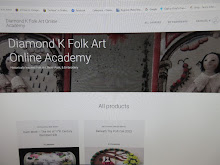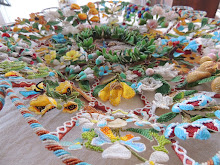I recently received an email to me that said "It is a refreshing pleasure to meet someone who incorporates artistry into daily life"...... what a nice compliment I thought. I had simply taken the time to address an envelope in an early 19th style of writing....never thought anything of it really, other than, that I liked to do it. I live a very moderne life...running water, wonderful Heavenly toilettes inside the house....and this computer~ a wonder of the world to be sure! But I do love history, and am always thinking of how things would have been done, in my favorite 18th century. When on a trip, I often ponder and calculate how long it would have taken to get there in a carriage, at a blazing 5 mph......and the other night at supper, was telling the children how spoiled we are to have a refrigerator....that in early times, one would have to go to market every morning to buy the days meat and bits for supper.
Well, before Halloween, we got a wholloper of a snow here in southern Colorado, with a bit of rain before, that has turned or drive and road we live on, into a muddy mess. Looking at all that mud, and sweeping it up out of the house constantly, I digress again to what our ancestors would have had to deal with in the late 18th and early 19th c. No rubber mud boots. nope. They had 'Pattens'

Pattens had a flat metal hand forged ring which made contact with the ground, attached to a metal plate nailed into the wooden sole via connecting metal, that elevated the foot up off the ground, sometimes several inches. I have read about pattens being worn as early as the 1500's, but they were most common from the 18th c to second quarter 19th c, when vulcanized rubber overshoes replaced them. You can find c1830 hybrids of a wooden sole with a rubber hinge in the middle of the instep. I am very fortunate to own 2 pair of early children's pattens here at the Museum

These two pair both measure almost 6" in length, and were actually worn by wee little children, just learning to walk.
Pattens were worn only outside, on muddy country roads and messy brick paved city streets, to 'save ones shoes' from getting dirty. It was customary to take them off before entering a home, and especially Church. Matter of fact, many Churches had rules forbidding them. Jane Austen often wrote about the "ceaseless clink of pattens" when referring to her life in Bath, England. (I think she would go insane at all the city noise these days, and long for 'just' the clink clink clink of pattens!)
One can imagine the noise they made as a person walked across any hard surface, much like metal horseshoes on pavement now a days....and what an interesting trail they would leave in the mud!

This is the bottom view of my earliest pair, they date to 1780, and have an oval wrought iron ring to elevate the Adler wood platform up off the ground. This oval shape is the most common found, I have seen a gorgeous adult pair with heart shape 'ring', that I still kick myself for not buying when I had the chance.....

This pair date to the first quarter of the 19th century, and I date them by the shape of the sole. A person simply tied these on over their shoes, so the shape of the sole mirrored the fashionable shoes of the time. These have an interesting ogee, or lantern kind of a shaped iron 'ring'.
Looking at them, one might assume that they would have been made by a Blacksmith...but not so. Like so many Trades in the 18th Century, one must be a member of the 'Worshipful Company of Pattenmakers' to make them. My post heading is their motto, which translates from the Latin to ' Women Receive Support From Us'.
 The iron ring was attached the to bottom of the sole, with the front piece curving up and around the toe to protect the front of the shoe from being worn down.
The iron ring was attached the to bottom of the sole, with the front piece curving up and around the toe to protect the front of the shoe from being worn down. Wonderful early craftsmanship in a utilitarian piece of clothing....so hard to come by today.
Wonderful early craftsmanship in a utilitarian piece of clothing....so hard to come by today. I really love this bottom view~ if you click on and enlarge it, you will notice the wear to the wood on the inner sides. From this, we can tell which shoe was right and left, and that this little person walked with great ease in them on paved streets, to wear down the wood in this pattern.
I really love this bottom view~ if you click on and enlarge it, you will notice the wear to the wood on the inner sides. From this, we can tell which shoe was right and left, and that this little person walked with great ease in them on paved streets, to wear down the wood in this pattern. 






















No comments:
Post a Comment